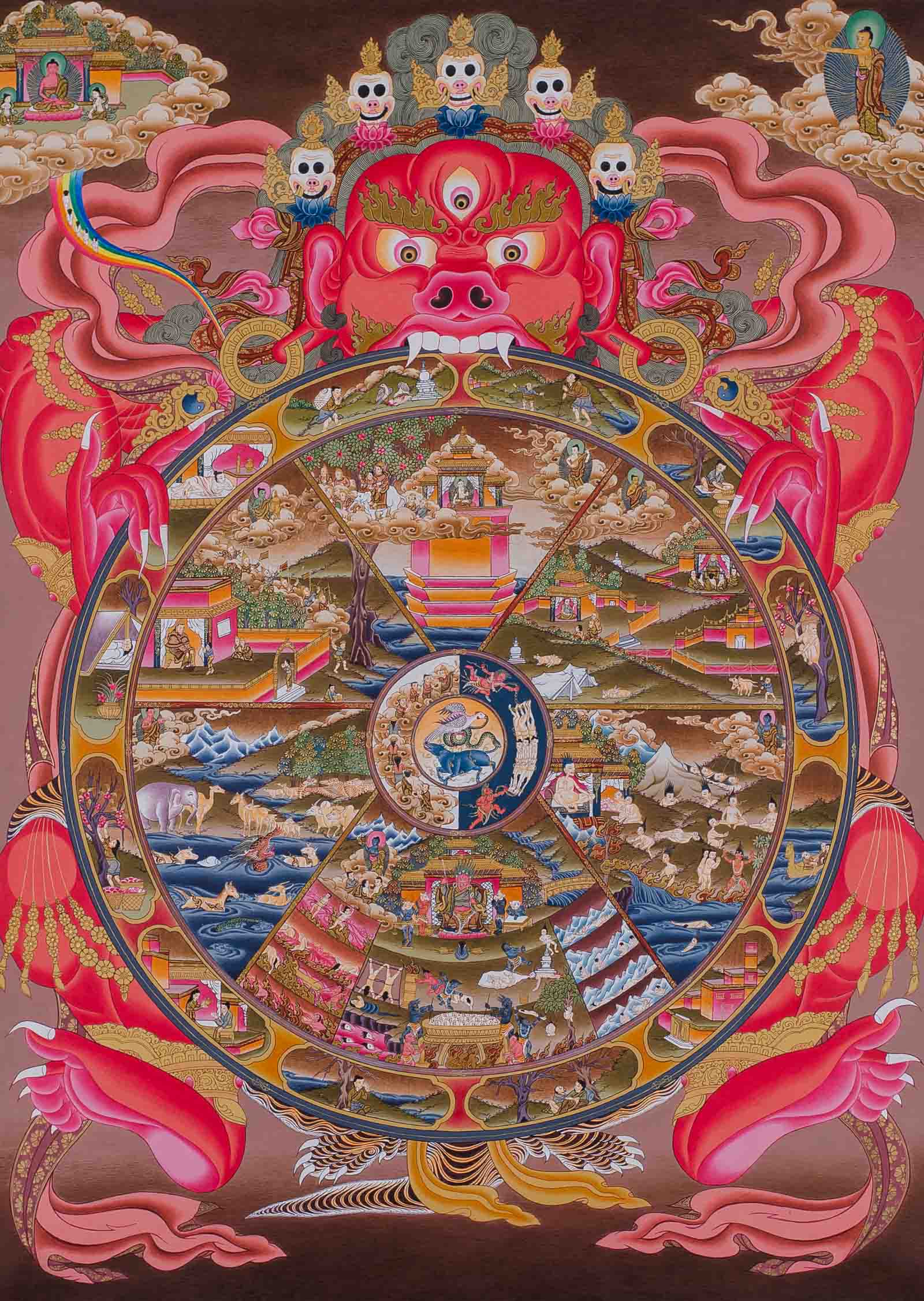
When someone asks - what does Samsara mean ? The answer can be shortened to - all existences that are conditioned by: ignorance, suffering and the inexplicable flow of time.
Often painted on the exterior walls of Buddhist monasteries, The Wheel of Life can be considered the very essence of the Buddhist philosophy as it offers insights into some of its most important concepts. It depicts and explains the cyclic nature of re-incarnation and the different aspects of our perceived reality. It also shows the importance our actions have on our existence - or what we like to call Karma.
The notion of re-incarnation is also to be found in Vedic literature - "bhavachakra" in Sanskrit is a synonym of the word Samsara. This can be divided into - bhava - which means origin or worldly existence and - chakra - which means circle or rotation. This idea of a rotation or cycle, is in fact re-incarnation ! We do not occupy a stable place within Samsara, but depending on our Karma we will pass from one existence to another.
Beyond the Samsara we have Nirvana, the world unaffected by negative emotions, which by definition is the true nature of happiness and the ultimate realization that we are all seeking for. We are all Buddhas waiting to become enlightened.
This motif is a little more complex than the introduction I gave here, scroll down if you wish to read a more detailed look or buy a wheel of life . I have tried to divide the different elements of the Thangka into sections, so you can better understand this beautiful painting.
The three poisons or the three fundamental sufferings (by this I mean the three things from which we suffer every hour of every day until we reach nirvana) occupy the center of the Wheel of Life, as they act as “fuel” giving momentum to the “wheel”.
3 POISONS OF SAMSARA
- Desire : represented by a cockerel.
- Hatred/Jealousy : represented by the snake.
- Ignorance : Represented by a boar.
The use of animals as imagery here is important, we can see that each animal is holding onto the tail of the animal infront of him. Which symbolizes the fact that these negative emotions lead to each other in an endless loop. It is only by our effort and spiritual progress that we are able to gradually gain control and ultimately destroy these emotions.
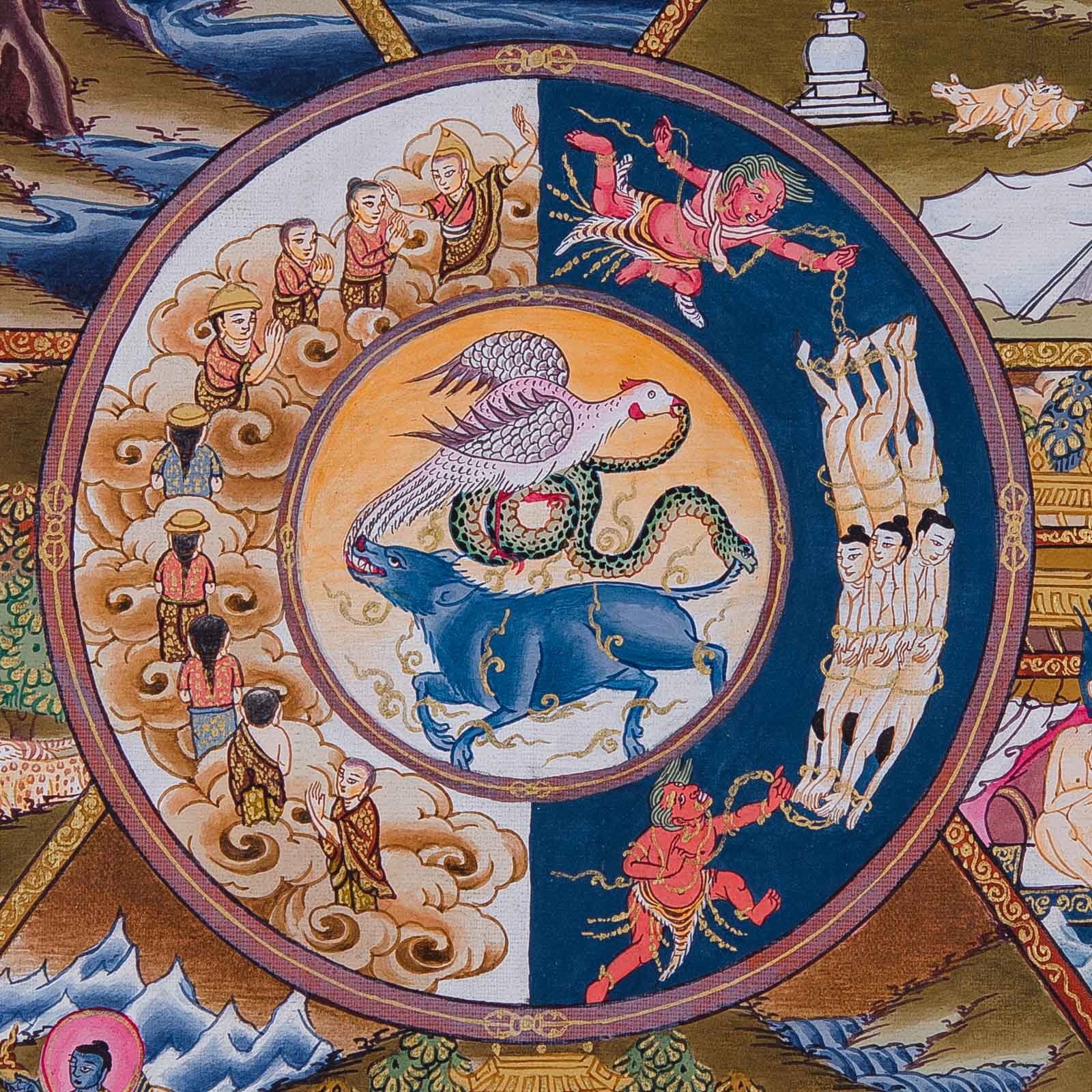
BARDO : BETWEEN DEATH AND RE-BIRTH..
The next circle out from the Wheel of Life is called Bardo and shows spirits pulled downwards by Demons (right), as they have forgotten Dharma and let the 3 Poisons overcome them. And disciples of dharma being lead upwards, having fought to overcome the 3 Poisons, and the negative karma that it brings.The term Bardo has no direct translation, as it roots itself in the concept of re-birth, something I consider to be relatively new to the “west”. It represents the state which our spirits find themselves in the moment between life and death – the Intermediate State.
Samsara begins at the subconscious state of Bardo, continues into birth and is completed at the moment of death, thus the imagery or literal translation : the Wheel of Life.
As our Karma matures, it will find itself in its corresponding “world”.
If individuals find themselves with similar Karmas, their conscious will experience, through common perceptions, an identical world. Humans for example, all have identical sense organs (the 5 senses) which grant them access to an identical world (ours). Buddhism however allows a multiplicity of possible manifestations, each functioning in a parallel “universe”.
THE 6 WORLDS OF SAMSARA
There exist 6 worlds : Gods, Titans, Humans, Animals, Hungry Spirits and Hell. We as humans can only perceive two: the Human world (ours) and the Animal world. From a Buddhist perspective , the fact we cannot perceive the other worlds does not condemn their existence, but further proves that we are blinded by what we can see, touch, taste, hear and smell. The existence of the 6 worlds is demonstrated by the numerous enlightened beings that possess faculties that are far superior to ours.
The 6 worlds of the Wheel of Life can also be split into 2 groups:
- Three Upper Worlds : Gods, Titans and Humans, in which happiness is greater than suffering.
- Three Lower Worlds : Animals, Hungry Spirits and Hell, in which suffering is greater than happiness.
1 – GODS – The Highest Order
The gods (déva), during the course of extremely long lives, enjoy the pleasure of all things. Their suffering comes at the end of their lives, when they are rejected by their community and glimpse into the world in which they will be re-born which, by definition, will be a lesser world, having drained their merits bathing for centuries in more luxuries than we may dream of.
Pride associated with large amounts of positive karma can lead you to be re-born in this part of the Wheel of Life.
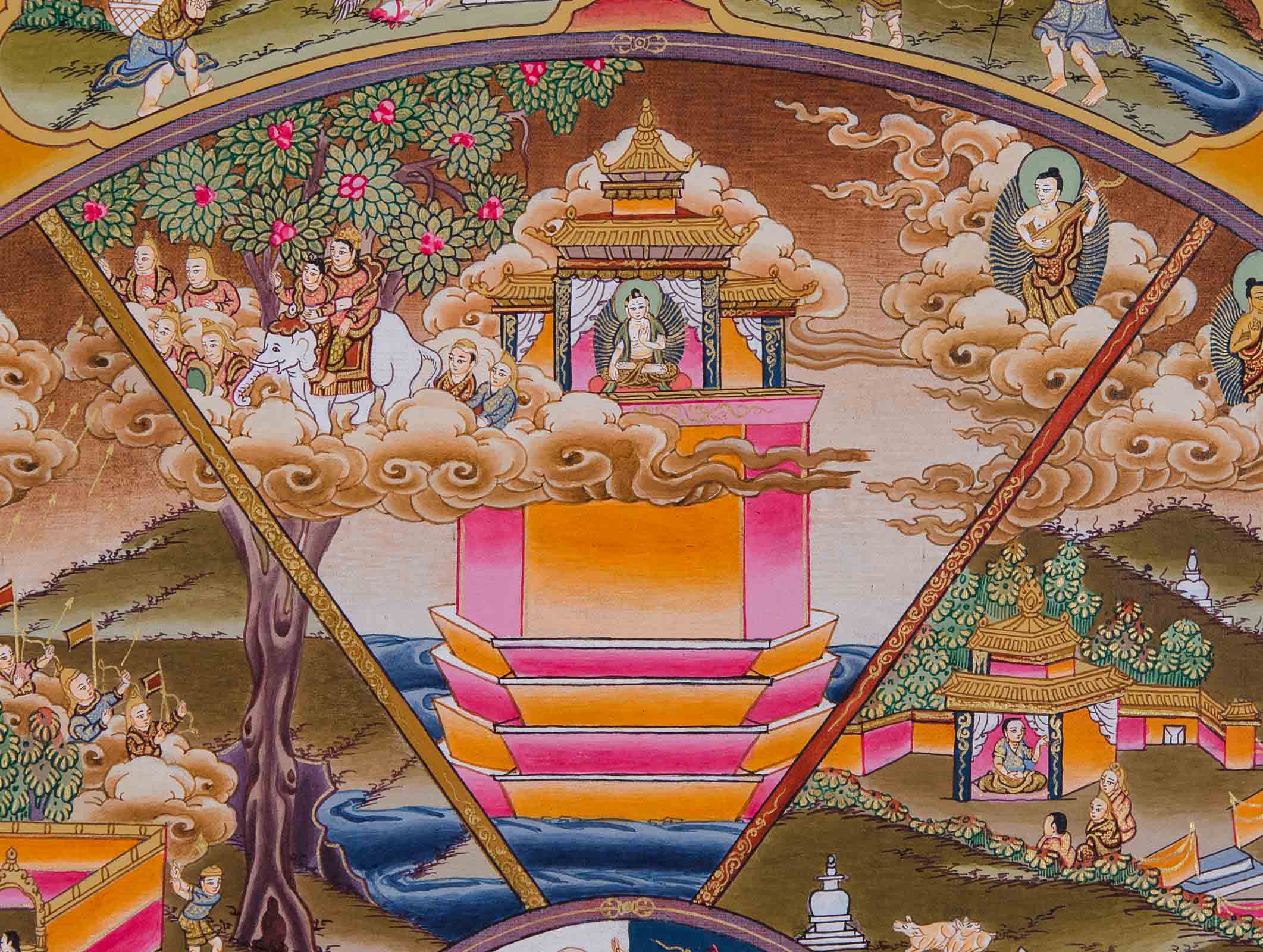
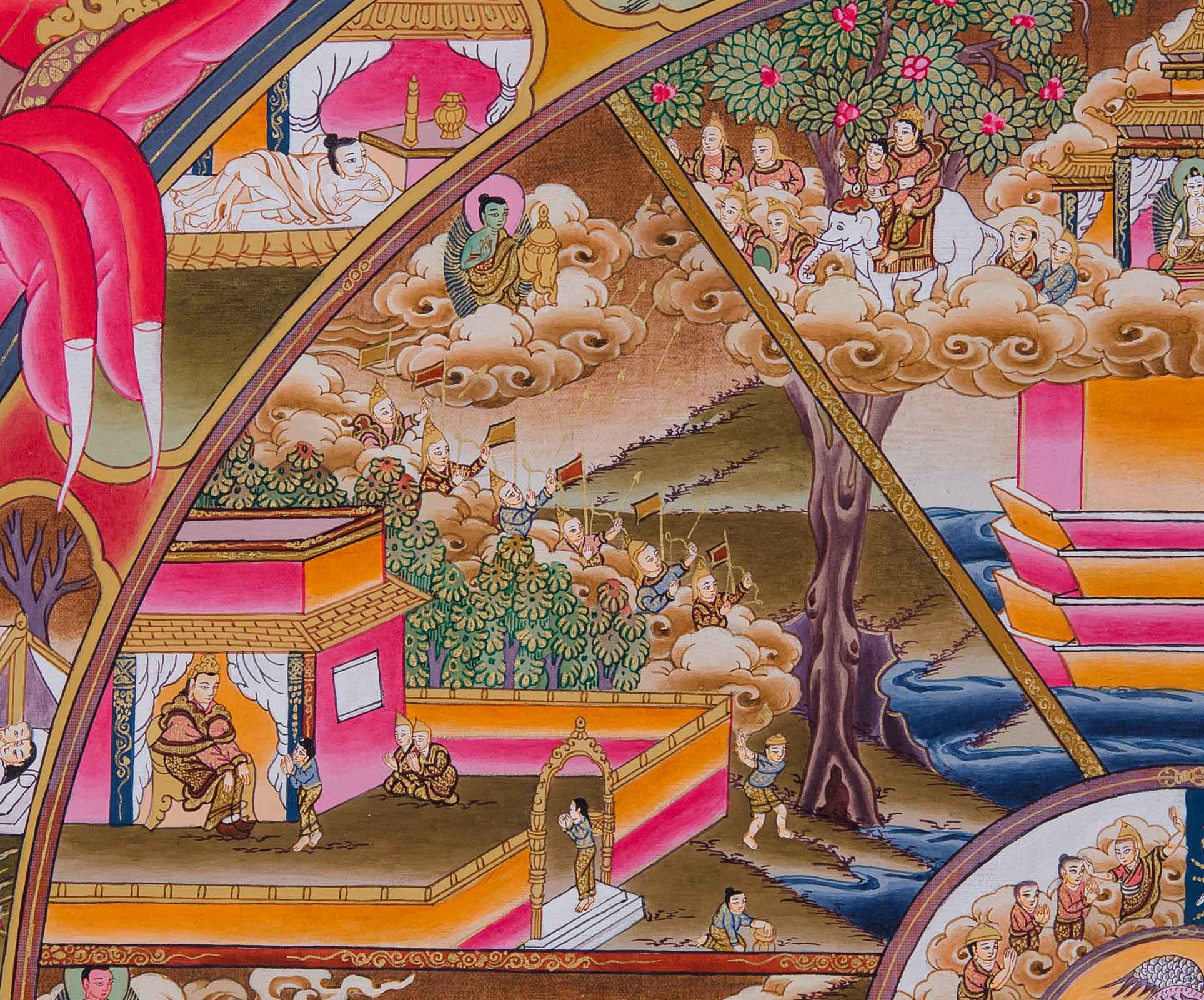
2 – THE TITANS – Samsara at work
The Titans (assoura) or demi-gods are very powerful beings whose main occupation and suffering is to be constantly engaged in conflicts and arguments.
Legend has it that the Tree of Life grows in this world, but the Fruit of Eternal Life which it bears, falls into the World of the Gods. Which is the nature behind their Jealousy and Constant conflict with the Gods.
Jealousy associated with some good karma leads to rebirth in this realm of the Wheel of Life.
3 – HUMANS – Our Existence
Humans (mansuya)suffer principally from : birth, ageing, sickness, and death, but also from many other sufferings and difficulties. Unlike the other worlds it is possible to get spiritual teaching in this world, which is not the case for the other worlds.
Desire, coupled with a superior capacity for good karma rather than bad karma, leads to rebirth in this realm of the wheel of life.
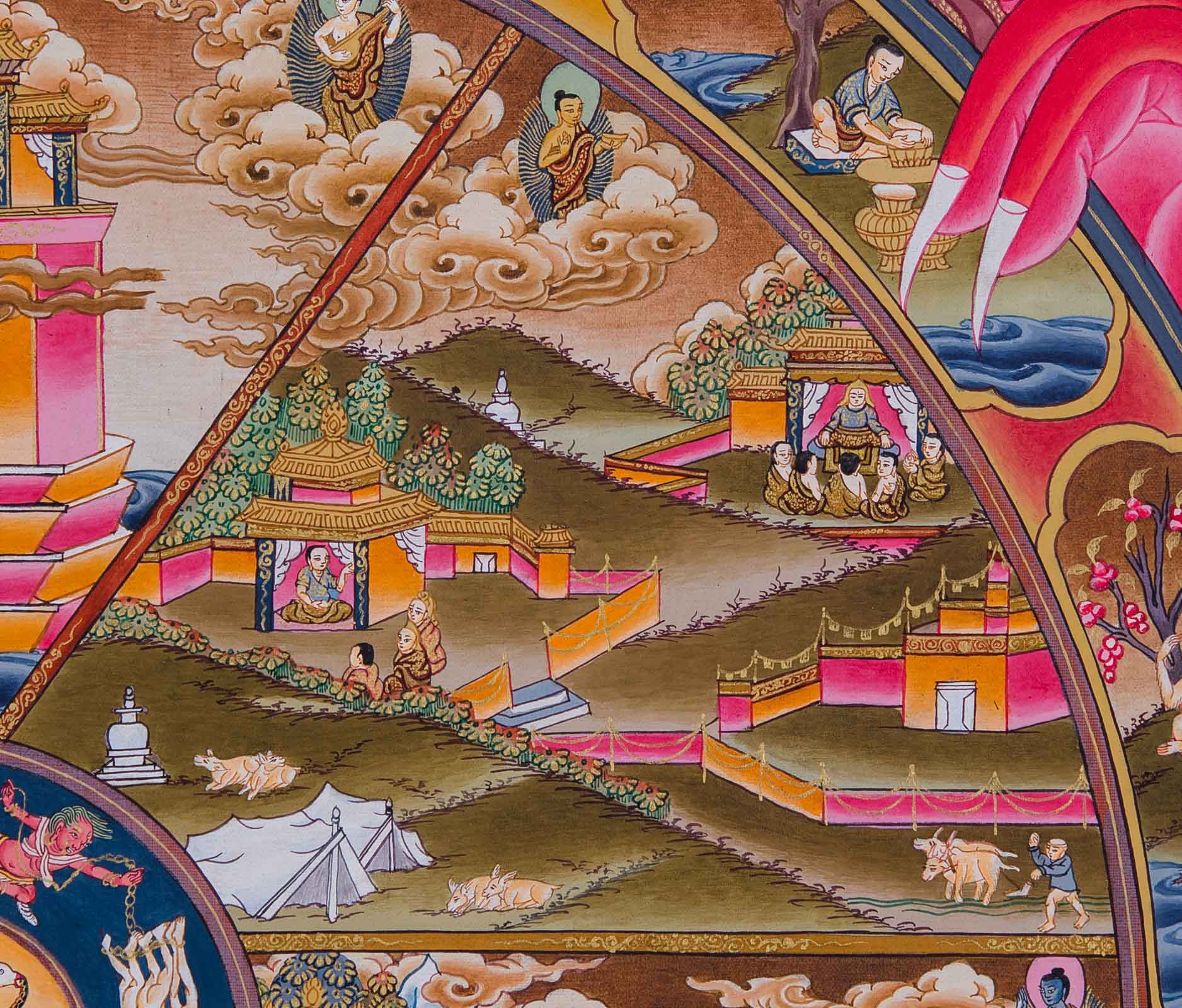
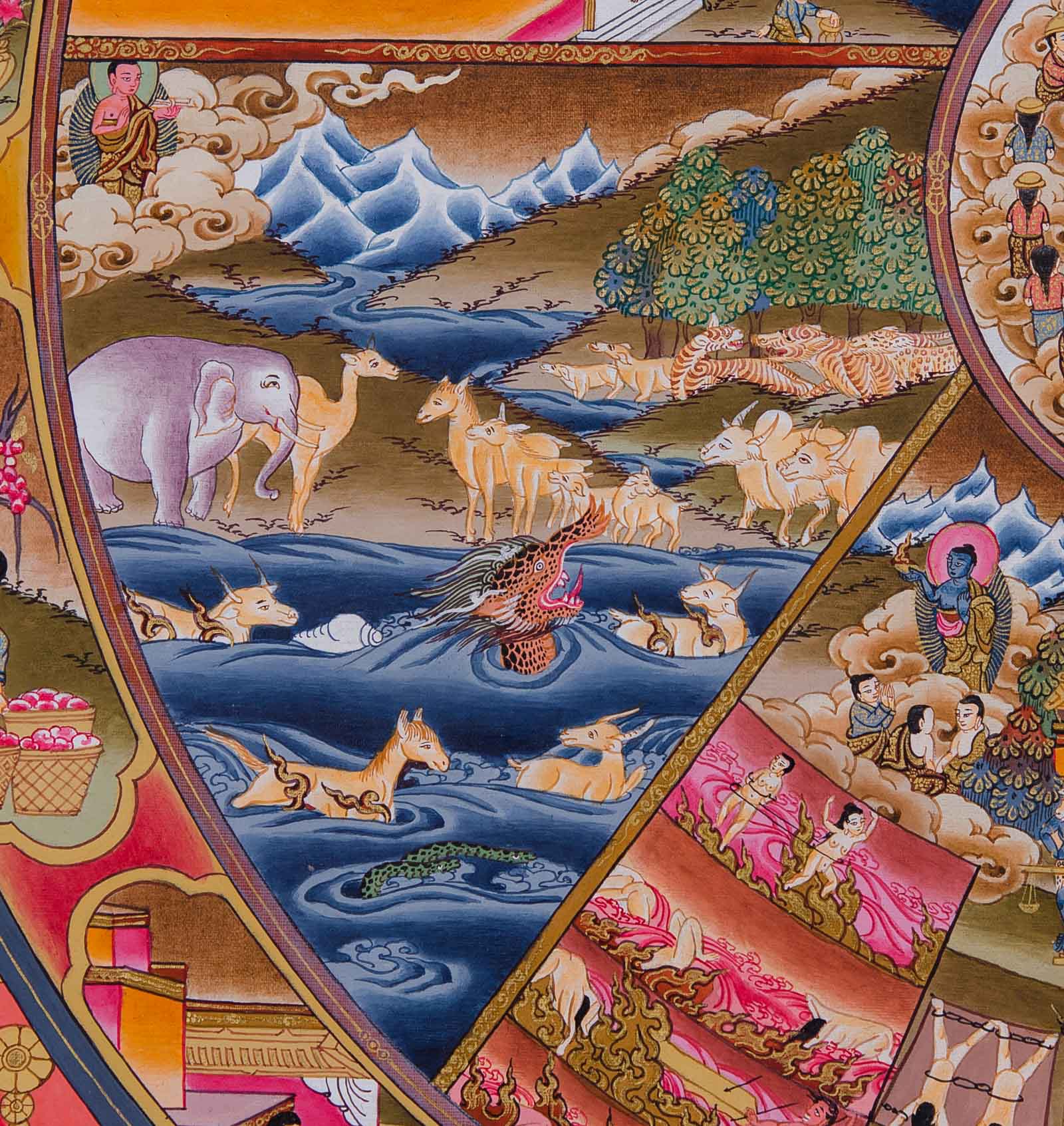
4 – ANIMALS – Everyday Samsara
Animals (tiryanca) suffer from cold, hunger, sickness, cannibalism, enslavement and exploitation by humans. They also suffer from very limited intelligence.
The negative karma that is associated to ignorance leads to rebirth in the animal world of Samsara.
5 – HUNGRY SPIRITS – The beginning of “hell”
The hungry spirits suffer from a hunger and thirst that can never be quenched or satisfied by the seldom occasions they find food or water.
Greed and the negative karma associated with it will lead to rebirth in this realm of the Wheel of Life.
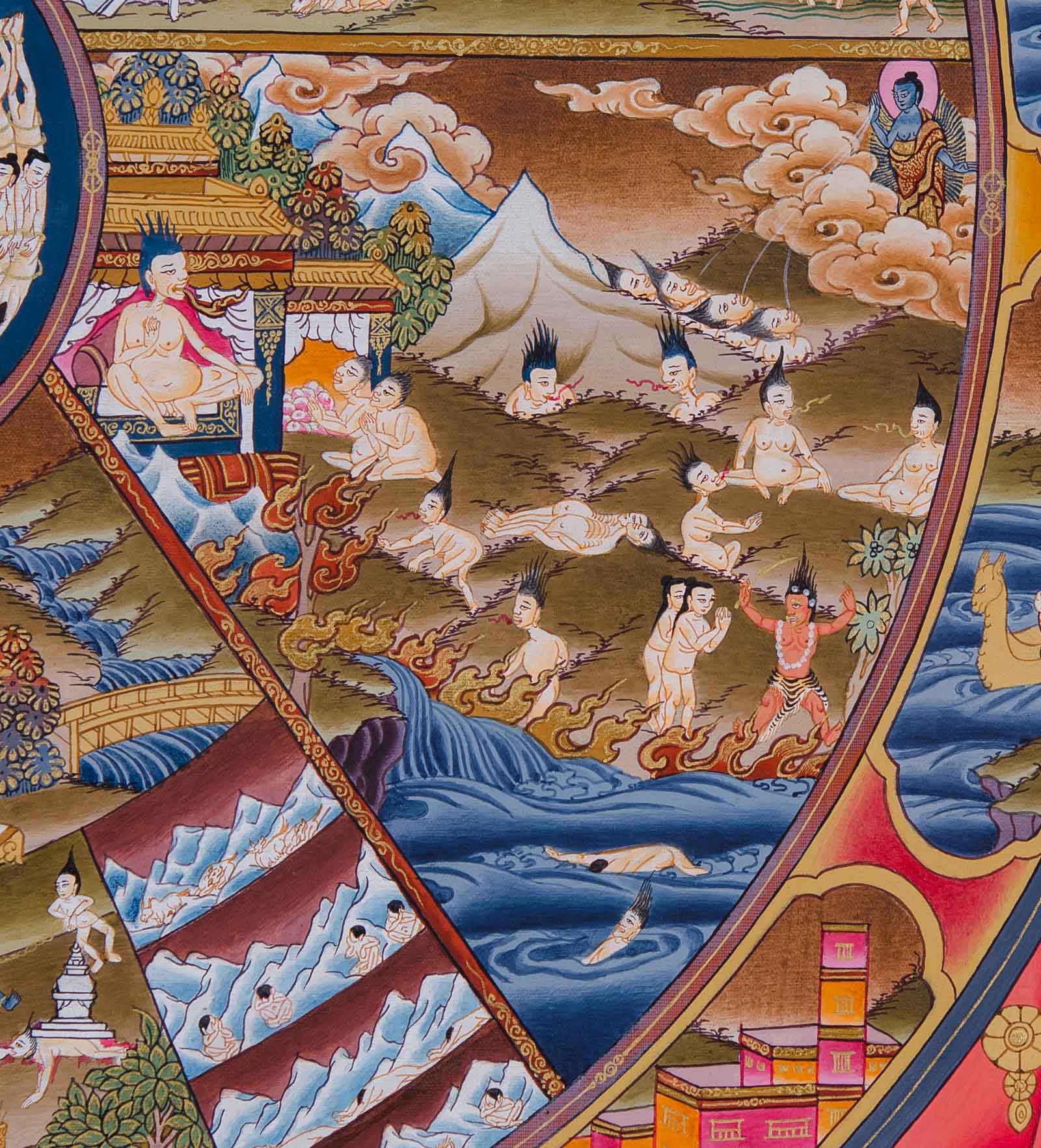
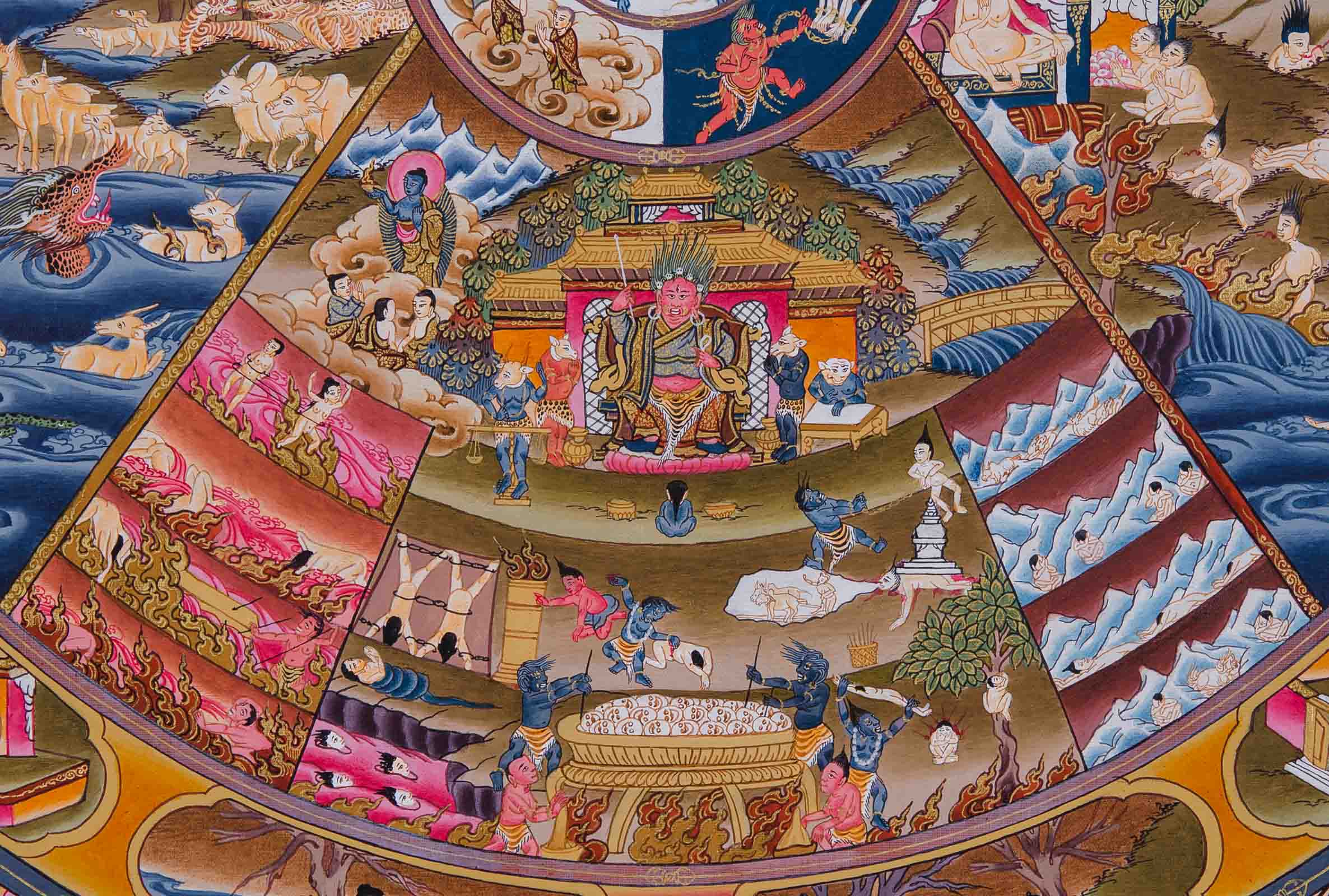
6 – THE DAMNED – Hell in Buddhism
The damned (naraka) are those who live in Buddhist hell, worlds of intense suffering in which life is extremely long. The beings that find themselves there are subject to torture with fire and ice and numerous other sufferings.
Negative karma associated to hatred, will lead to rebirth in Samsara hell.
A BUDDHA FOR EACH WORLD : SAMSARA
The understanding of the wheel of life or Samsara as some prefer to call it, would not be complete without this vital piece of information: The human world, due to a balance between good and evil, makes spiritual practice easier to accomplish, and hence is favoured by the Buddhas. But it is not because they favour our (human) world that they do not intervene in all the worlds to lessen the burdens of suffering that all beings carry and if possible lead them to the path of liberation (enlightenment). There are 6 groups of Buddhas that act in each world :
- INDRA “Offerings a Hundredfold” – white in colour, for the Gods
- VEMACITRA “Splendid Robe” – green in colour, for the Titans.
- SHAKYASIMHA “Lion of the Shakyas” – yellow in colour, for the Human World.
- DHRUVASIMHA “Unmovable Lion” – green in colour, for the Animal World.
- JVALAMUKHA “Flamboyant Mouth” – red in colour, for the world of the Hungry Spirits.
- DHARMARAJA “King of Dharma” – black in colour, for Hell.
As you can see from the list above, no world is forgotten and enlightenment is possible from any of the worlds, yet as explained above the balance between good and evil found in our world, allows us a larger capacity to escape the grips of Yama,perhaps after many hours of meditation, multiple Siddhis, endless generosity and happiness.

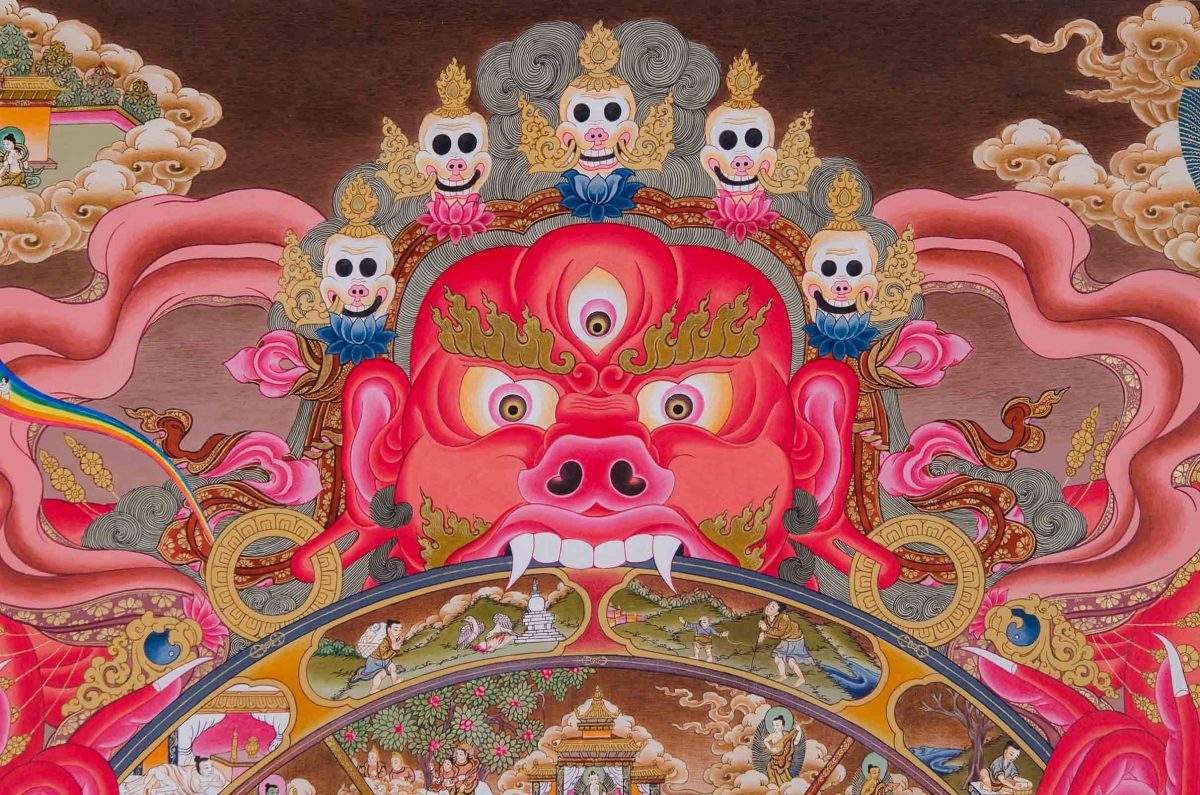
Comments 21
Thank you for visiting my site – mandalas.eu! You’ve got an interesting blog here. It will be visited by me often!
Love,
Timea
Very nice interpretation of the Wheel Of Life.
Bonjour Satcheen, là encore voici une présentation très intéressante et très bien documentée sur La Roue de La Vie. Sans parler de la thangka que nous présente, elle est superbe!!!
Vraiment passionnant! merci Satcheen de partager avec nous ta connaissance sur l’Art de la Thangka, véritable joyau de l’Art Bouddhiste!!
Pingback: Avaloketeshvara | Thangka Mandala
Pingback: Maitreya - Thangka of the Buddha to Come | Thangka Mandala
Hello,
Where is the best place at home where to put the picture of Weel of life? Can it be living room, southwest wall? Thank you!
Author
The living room is a lovely place to put a Wheel of Life. Generally North and East are considered to be the directions associated with the divine. Yet this rule is relative to a place of worship, therefore if you are interested in using this Thangka for meditation, I would recommend choosing either North or East (North-East will do).
The only place that is considered “wrong” is the kitchen or a wall at the foot of a bed, as the Thangka would then be facing to soles of your feet which is highly inauspicious.
We live in a world of constraints, so if the southwest wall is the only place, the Buddhas with all their compassion will not hold it against you!
Please, can I use pictures from this site to my e-book? Of course I will put the link to this author site :-).
Please, can You write explanation to the wheel with 12 symbols – potter, monkey on the tree, 2 persons in the boat etc. Thank You.
I am preparing teaching material and a PHD proposal which will later form the bases of the PhD. Can I use material from this article, pictures and text? I will include a link to your blog.
Author
Absolutely. Good luck!
Hello, This has been a very interesting read for me as i was given a Thangka a few years ago while living in Japan. I sort of knew what it was but really understood the meaning behind it. How would i go about finding out what story my Thangka tells?
Thank you
Cherie
Your explanation of the wheel of samsara was most beneficial this evening. I was trying to explain to gf that most people who say “karma” don’t really know what they’re talking about. It is very similar, not the same as what Jesus said in Mathew: “Do unto others…”
Pingback: Selbstfindungsreise Nepal Teil 1 – Highly Sensitive Life
Pingback: 10 Ways to Enhance Immunity - CrownOfMind.Com
Pingback: Downshifting to Collective Liberation | Angela Anderton
Pingback: De la Ouroboros la Enso – Artela
Pingback: Word Craft Poetry“At the Top of the World,” shadorma sequence
Pingback: What Judaism Says About Reincarnation – Center for Pluralism
Pingback: The Thirteenth Hour Podcast #386: The Marginal Utility of Time, Reflections on 2022, and Future Goals – The Thirteenth Hour
Pingback: Summery Reincarnation – Kabbalah